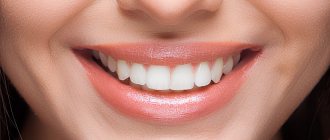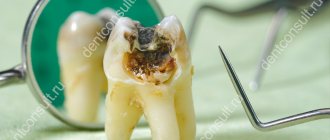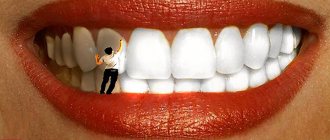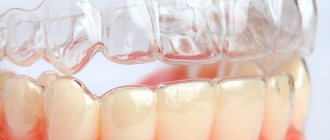The procedure for deep fluoridation of teeth is designed to increase their strength by saturating the surface layer with fluoride and blocking the loss of minerals from tooth enamel. During the work, the oral cavity is first cleaned, after which it is treated with two types of protective compounds.
The first composition penetrates into existing pores, filling them, and the second composition consolidates the results of the primary treatment.
The use of enamel-sealing compounds is due to the following cases:
- Combating the development of caries;
- Mineralization of fissures;
- Counteraction to various types of enamel damage;
- The need to reduce the sensitivity of the tooth neck;
- Carrying out teeth whitening.
Dentists prescribe fluoridation to patients after removing braces, when a significant amount of plaque accumulates in hard-to-reach places, as well as in cases where daily oral hygiene procedures encounter pain for the patient.
What is dental fluoridation?
Fluoridation of teeth is an effective method of strengthening tooth enamel and protecting teeth from caries.
A deficiency of fluoride and calcium in the human body inevitably leads to the destruction of dentin (the main part of the tooth) and the enamel covering it. The result is increased tooth sensitivity, a tendency to develop caries, and periodontal disease.
Fluoridation is a painless and absolutely safe procedure, the essence of which is to apply a thin layer of fluoride-containing compounds (fluorides) to the surface of the teeth.
After fluoridation, it is recommended not to eat for several hours (4-6 depending on the drugs used), and also not to drink too hot or, conversely, cold drinks. In addition, you should refrain from eating solid food for 24 hours. These recommendations are due to the possibility of damaging the protective layer of fluoride applied to the teeth. If deep fluoridation has been carried out, you can eat and drink immediately.
Deep fluoridation
Orthodontist-dentist Nikolaeva Nadezhda Nikolaevna
Fluorine is a chemical element (symbol F, atomic number 9), a non-metal that belongs to the group of halogens. It is the most active and electronegative substance. Along with other mineral elements, it plays an important role in the processes occurring in the human body. In particular, it participates in hematopoiesis, immune reactions, plays an important role in the restoration of bones during fractures, prevents the development of osteoporosis, participates in the formation of the skeleton and, of course, prevents the development of caries. Deep fluoridation of teeth is a modern method of protecting enamel from caries, which was invented by a scientist from the Institute of Physical Chemistry of the University of Hamburg, Adolf Knappvost. Deep fluoridation is the remineralization of teeth in order to protect and strengthen them, as well as prevent the occurrence of caries. Before fluoridation, professional teeth cleaning is required. The procedure itself is similar to home whitening. Our laboratory has recently made it possible to manufacture retention aligners with a silicone backing; these aligners not only hold teeth in the desired position, but also allow you to use them for home teeth whitening and fluoridation. A custom mouth guard is filled with fluoride gel and placed on the upper and lower jaws. Highly dispersed calcium fluoride and magnesium, which are part of the gels for deep fluoridation, fill and, as it were, seal the enamel pores. After this, the teeth are treated with copper/calcium hydroxide, under the influence of which a solution of calcium fluoride appears, saturated with fluoride ions. Alkaline copper fluoride is also formed, which has a high bactericidal effect. Copper ions, even in small quantities, have an excellent anti-caries effect. After the procedure, a thin coating is formed on the teeth, which actively counteracts caries and fills enamel microcracks within two years. There are several types of gels for deep fluoridation, but their principle of action and purpose are the same. Deep fluoridation does not harm enamel and does not interfere with teeth whitening. This procedure is indicated for use no more than once a year. It is especially useful for teeth with thin enamel and for people living in regions with low fluoride content in drinking water. Below is a table of Russian regions with fluoride content in drinking water:
deep fluoridation price
| № | Region | Settlements, regions | Fluoride content in drinking water, mg/l | Characteristics * |
| 1 | Republic of Adygea | Maykop | 0,07 | Below normal |
| 2 | Arhangelsk region | Arkhangelsk | 0,15 | Below normal |
| Kholmogory | 0,19 | Below normal | ||
| 3 | Astrakhan region | Astrakhan | 0,08-0,16 | Below normal |
| 4 | Republic of Bashkortostan | Ufa, Sipailovo District | 0,28 | Below normal |
| Ufa, Sovetsky district | 0,20 | Below normal | ||
| Ufa, Kalininsky district | 0,16 | Below normal | ||
| Iglino | 0,31 | Below normal | ||
| Naumovka | 0,28 | Below normal | ||
| 5 | Bryansk region | Bryansk, Sovetsky district | 0,18 | Below normal |
| Bryansk, pos. Kuzmino | 0,41 | Below normal | ||
| 6 | The Republic of Buryatia | Ulan-Ude, Sovetsky district | 0,48 | Below normal |
| Oktyabrsky district | 0,36 | Below normal | ||
| Kyakhtinsky district | 0,48 | Below normal | ||
| Suburb of Ulan-Ude | 0,45 | Below normal | ||
| Selenginsk | 0,3 | Below normal | ||
| 7 | Volgograd region | Volgograd, Central district | 0,22 | Below normal |
| Svetly Yar | 0,2 | Below normal | ||
| Northern district (Traktorozavodsky) | 0,2 | Below normal | ||
| Northern district (Krasnooktyabrsky) | 0,21 | Below normal | ||
| North-Western region (Dzerzhinsky) | 0,2 | Below normal | ||
| Southern district (Krasnoarmeysky) | 0,2-0,22 | Below normal | ||
| Elan | 0,68 | Norm | ||
| Gorodishche town | 0,18-0,49 | Below normal | ||
| Surovkino | 0,6 | Norm | ||
| 8 | Voronezh region | Voronezh, Levoberezhny district | 0,25-0,35 | Below normal |
| Greenhouse area | 0,25-0,35 | Below normal | ||
| Sovetsky district | 0,25-0,35 | Below normal | ||
| Pos. Maslovka | 0,25-0,35 | Below normal | ||
| Borisoglebsky district | 0,25-0,35 | Below normal | ||
| Liskinsky district | 0,25-0,35 | Below normal | ||
| 9 | The Republic of Dagestan | Makhachkala | 0,2 | Below normal |
| Buinaks | 0,2 | Below normal | ||
| Sulevkent city | 0,42 | Below normal | ||
| With. Tsudahar | 0,36-0,43 | Below normal | ||
| With. Kumukh | 0,3 | Below normal | ||
| With. Kasumkent | 0,23 | Below normal | ||
| 10 | The Republic of Ingushetia | Nazran | 0,17 | Below normal |
| Sleptsovsk | 0,15 | Below normal | ||
| Karabulak | 0,25 | Below normal | ||
| With. Ekazhevo | 0,22 | Below normal | ||
| 11 | Irkutsk region | Irkutsk | 0,21 | Below normal |
| Angarsk | 0,23 | Below normal | ||
| Gadalei | 0,12 | Below normal | ||
| Savvateevka | 0,19 | Below normal | ||
| 12. | Republic of Kabardino-Balkaria | Nalchik | 0,23-0,41 | Below normal |
| Tyrny-Auz | 0,38 | Below normal | ||
| Prokhladny | 0,22-0,29 | Below normal | ||
| 13 | Republic of Karelia | Petrozavodsk | 0,08 | Below normal |
| Sortavala | 0,02 | Below normal | ||
| village Nadvoitsy | 0,9 | Norm | ||
| 14 | Kemerovo region | Kemerovo, Central district | 0,3-0,5 | Below normal |
| Leninsky district | 0,3-0,5 | Below normal | ||
| Novokuznetsk, Dragunsky water intake | 0,62 | Norm | ||
| Left Bank water intake | 0,11-0,38 | Below normal | ||
| Leninsk-Kuznetsky | 0,19 | Below normal | ||
| Yurga | 0,22 | Below normal | ||
| 15 | Krasnodar region | Krasnodar city | 0,42-0,54 | Near the lower limit of normal |
| Gelendzhik | 0,15-0,17 | Below normal | ||
| village Yablonovka | 0,3 | Below normal | ||
| Primorsko-Akhtarsk | 0,6 | Norm | ||
| Stanitsa Starominskaya | 0,64 | Norm | ||
| 16 | Krasnoyarsk region | Krasnoyarsk, Central district | 0,13 | Below normal |
| Kirovsky district | 0,13 | Below normal | ||
| Sovetsky district | 0,13 | Below normal | ||
| Divnogorsk | 0,12-0,15 | Below normal | ||
| 17 | Kursk region | Kursk, Central district | 0,26 | Below normal |
| Industrial area | 0,36 | Below normal | ||
| Northwestern region | 0,41 | Below normal | ||
| Zheleznogorsk | 0,37 | Below normal | ||
| 18 | Lipetsk region | Lipetsk | 0,2 | Below normal |
| Gryazinsky district | 0,24 | Below normal | ||
| 9 | Moscow | 0,16-0,22 | Below normal | |
| 20 | Moscow region | Mozhaisk | 0,41-0,61 | Near the lower limit of normal |
| Dmitrov | 0,6 | Norm | ||
| Dmitrovsky district | 0,6 | Norm | ||
| village Novo-Sinkovo | 0,6 | Norm | ||
| village Rybnoe | 0,6 | Norm | ||
| village Catoire | 0,6 | Norm | ||
| Vidnoe | 1,2 | Optimal | ||
| Odintsovo | 1,8 | Above normal | ||
| Podolsk | 1,2 | Optimal | ||
| Shchelkovo | 0,8 | Norm | ||
| Zhukovsky | 0,7 | Norm | ||
| Zheleznodorodny | 1,0 | Optimal | ||
| Yegoryevsk | 1,8 | Above normal | ||
| Noginsk | 0,36 | Near the lower limit of normal | ||
| Naro-Fominsk | 0,5 | At the lower limit of normal | ||
| Krasnogorsk | 3,0 | Above normal | ||
| Istra | 1,1 | Optimal | ||
| Kaliningrad | 0,2 | Below normal | ||
| Mytishchi | 0,16 | Below normal | ||
| Dolgoprudny | 0,5 | At the lower limit of normal | ||
| Klin | 0,6 | Norm | ||
| Losino-Petrovsk | 0,8 | Norm | ||
| 21 | Murmansk region | Murmansk | 0,1 | Below normal |
| Monchegorsk | 0,2 | Below normal | ||
| 22 | Nizhny Novgorod Region | Nizhny Novgorod | 0,1-0,5 | Below normal |
| Zavolzhye | 0,1-0,5 | Below normal | ||
| Arzamas | 0,86-1,2 | Optimal | ||
| village Syava | 1,86-2,56 | Above normal | ||
| 23 | Novosibirsk region | Novosibirsk, Central district | 0,17 | Below normal |
| Kirovsky district | 0,16 | Below normal | ||
| Kalininsky district | 0,16 | Below normal | ||
| Iskitim | 0,39 | Below normal | ||
| Toguchin | 0,39 | Below normal | ||
| village Kochenevo | 0,28 | Below normal | ||
| 24 | Omsk region | Omsk, Sovetsky district | 0,25 | Below normal |
| Pervomaisky district | 0,18 | Below normal | ||
| Maryanovsky district | 0,16 | Below normal | ||
| 25 | Penza region | Penza | 0,41 | Below normal |
| Serdobsk | 2,85-2,9 | Above normal | ||
| village Kolyshley | 0,4 | Below normal | ||
| 26 | Primorsky Krai | Vladivostok | 0,11 | Below normal |
| Komsomolsk-on-Amur | 0,16 | Below normal | ||
| 27 | Rostov region | Rostov-on-Don | 0,28 | Below normal |
| Taganrog | 0,28-0,3 | Below normal | ||
| 28 | Samara Region | Samara, Bogatovsky district | 0,22 | Below normal |
| Kirovsky and Zheleznodorozhny districts | 0,52-1,3 | Normal, close to optimal | ||
| Kuibyshevsky and Industrial districts | 0,52-1,3 | Normal, close to optimal | ||
| Tolyatti | 0,21 | Below normal | ||
| Syzran | 0,24-0,39 | Below normal | ||
| Chapaevsk | 0,48-0,5 | Near the lower limit of normal | ||
| With. Big Chernigovka | 0,12-0,28 | Below normal | ||
| 29 | Sakhalin region | Yuzhno-Sakhalinsk | 0,1-0,2 | Below normal |
| village Trinity | 0,1 | Below normal | ||
| village Sinegorye | 0,08 | Below normal | ||
| 0 | Sverdlovsk region | Yekaterinburg city | 0,7 | Optimal |
| 31 | Smolensk region | Smolensk, Demidovsky district | 0,28-0,35 | Below normal |
| Smolensk, Industrial and Leninsky districts | 0,29-0,35 | Below normal | ||
| With. Ershichi | 0,29-0,35 | Below normal | ||
| 32 | Republic of Tatarstan | Kazan, Vakhitovsky district | 0,16 | Below normal |
| Kazan, Novo-Savinovsky district | 0,15 | Below normal | ||
| Kazan, Suburb Derbyshki | 0,19 | Below normal | ||
| Zelenodolsk | 0,37 | Below normal | ||
| Zelenodolsk district of the village. Vasilyevo | 0,36 | Below normal | ||
| Almetyevsk | 0,19 | Below normal | ||
| Almetyevsky district, Boriskino village | 0,26 | Below normal | ||
| 3 | Tver region | Tver | 0,79-2,0 | From optimal to overpriced |
| 34 | Tomsk region | Tomsk | 0,29-0,08 | From low to optimal |
| village Timiryazevo | 0,07 | Optimal | ||
| 5 | Tula region | Tula | 0,26-0,28 | Below normal |
| 36 | Tyva Republic | Kyzyl | 0,22 | Below normal |
| With. Bai-Taiga | 0,43 | Below normal | ||
| 37 | Republic of Udmurtia | Izhevsk | 0,12 | Below normal |
| Votkinsk | 0,19 | Below normal | ||
| Sarapul | 0,16 | Below normal | ||
| With. Karakulino | 1,78 | Above normal | ||
| village A game | 2,54 | Above normal | ||
| Glazov | 0,15 | Below normal | ||
| village Kez | 3,02 | Above normal | ||
| With. Yak-Bodya | 0,31 | Below normal | ||
| 38 | Khabarovsk region | Khabarovsk | 0,15 | Below normal |
| With. Choir | 0,15 | Below normal | ||
| 39 | Khanty-Mansi Autonomous Okrug | Khanty-Mansiysk | 0,19 | Below normal |
| Urai | 0,1-0,14 | Below normal | ||
| Nizhnevartovsk | 0,1 | Below normal | ||
| Surgut | 0,12-0,35 | Below normal | ||
| 40 | Chelyabinsk region | Chelyabinsk | 0,23 | Below normal |
| Sosnovsky district | 0,15 | Below normal | ||
| Verkhniy Ufaley | 0,11 | Below normal | ||
| Magnitogorsk | 0,3 | Below normal | ||
| 41 | Chita region | Chita, Central district | 0,23 | Below normal |
| Chita, Zheleznodorozhny district | 0,3 | Below normal | ||
| 42 | Yaroslavl region | Yaroslavl | 0,14-0,17 | Below normal |
| Tutaev | 0,14 | Below normal |
* Characteristics according to Hygienic Standards for fluoride content in drinking water:
- optimal: 0.7-1.2 mg/l
- lower limit of normal: 0.5 mg/l
- upper limit of normal: 1.5 mg/l
Why coat your teeth with fluoride?
So what does fluoridation do? This method can be used by both adults and children to strengthen enamel and improve its strength properties.
Fluoride is an important element that not only makes enamel stronger, but also prevents the rapid proliferation of bacteria. Among other things, the resistance of teeth to an acidic environment increases, which means their surface becomes less susceptible to various types of destructive substances.
The fluoridation procedure must be repeated annually - then the teeth will be reliably protected from caries and not subject to premature destruction; The gradual leaching of calcium will stop, making the enamel stronger.
Types of fluoridation
Currently, fluoridation of teeth is carried out using two methods - simple and deep:
- Simple fluoridation . To carry out the procedure, special “spoons” are used that look like mouth guards, which are filled with a fluoride-containing composition and placed on the jaw for 10-15 minutes. To complete the full course, you need to conduct at least 10 sessions. An alternative option is simple fluoridation using a fluoride-containing varnish. It is applied with a special brush to the surface of the teeth and allowed to dry. The full course consists of 3-4 procedures, depending on the individual characteristics of the body and the drug used.
- Deep fluoridation . The main difference between this method and the previous one is the use of special enamel-sealing preparations. In addition, deep fluoridation requires careful preparation of teeth, therefore it is carried out exclusively in professional clinics. After the stage of cleaning the teeth, a special composition is applied to their surface using a tampon for 1-2 minutes, after which it is dried under the pressure of warm air. Then the surface of the teeth is stained with a swab dipped in calcium copper hydroxide milk, and then rinsed with clean warm water. The advantage of deep fluoridation is that the solution penetrates into the deep layers of enamel, making teeth much stronger. According to dentists, the effectiveness of deep fluoridation is 5 times higher than that of simple fluoridation.
Kinds
In dental practice, three methods of fluoridation of teeth are used:
- Simple fluoridation. Fluoride varnish is applied to the tooth surface or special trays and trays filled with gel with active elements are fixed. The duration of exposure to the composition is 10-20 minutes, and the number of sessions ranges from 10 to 15. The manipulation can be carried out in a dental office or at home. The regularity of its repetition depends on the condition of the tooth surface and predisposition to caries, and is 2-5 sessions per year.
- Deep fluoridation. The enamel is coated with a special solution, from which fluoride ions are released, penetrating deep into the tooth and transforming into strong compounds, which helps strengthen hard tissues. The procedure is carried out exclusively by a specialist and is repeated once a year.
- Electrophoresis. Strengthening of enamel occurs due to the effect of electric current on the tooth surface, which is successively coated with solutions of calcium gluconate and sodium fluoride. The therapeutic course consists of 10 procedures.
Benefit
As already mentioned, the main goal of fluoridation is to strengthen tooth enamel. In addition, there are other advantages of this procedure:
- The sensitivity of the teeth is reduced, so there is no discomfort when consuming cold and hot food or drinks.
- The risk of developing caries is reduced due to a reduction in the number of pathogenic bacteria and increased resistance of teeth to an acidic environment.
- Fluoridation prevents calcium from being washed out of tooth enamel, making teeth stronger and stronger.
Indications
Superficial caries is one of the indications for fluoridation of teeth.
Dentists recommend using the deep fluoridation service in the following cases:
- increased sensitivity of enamel;
- superficial carious lesions of the tooth surface;
- the need for non-invasive fissure sealing;
- inflammation of the ligamentous apparatus in the area of the tooth neck;
- accumulation of yellow plaque in the gingival area;
- completion of the orthodontic treatment process and removal of the braces;
- prevention of enamel thinning and caries development in childhood.
Harm
As you know, you need to know moderation in everything. Those who like to experiment with various fluoride-containing drugs need to know the following:
- Fluorides are toxic substances that in large quantities can cause serious harm to the human body. Therefore, if you prefer to use toothpastes with fluoride, then it is better to refrain from the fluoridation procedure. And vice versa - if you have coated your tooth enamel with fluoride, then you should choose toothpastes that do not contain this chemical element.
- Fluorosis is an excessive accumulation of fluoride in the body. Fluorosis leads to brittle bones, anemia, and neuralgic abnormalities. As for teeth, when fluoride accumulates excessively in them, the enamel begins to rapidly deteriorate, which invariably affects their appearance.
Contraindications
Fluorosis is an excess of fluoride.
Restrictions to the procedure are the following health characteristics of the patient:
- Diabetes. Increased fluoride levels interfere with the proper absorption of sugar, leading to disturbances in the functioning of the pancreas.
- Excess of the element in the body. A high content of non-metal in food and water consumed by humans, combined with local administration, can lead to the destruction of enamel.
- Allergy to the components of the drugs used.
- Fluorosis is damage to the enamel as a result of the presence of excess fluoride in it.
Fluoridation of teeth during pregnancy
During the period of bearing a child, most of all nutrients and minerals from a woman’s body go to the formation of the skeleton and muscle tissue of the unborn baby. Due to calcium deficiency during pregnancy, tooth enamel is destroyed, so fluoridation during this period is very useful. However, before applying fluoride to your teeth, you should have your mouth examined and consult an experienced dentist.
It is important to remember that severe toxicosis is the main contraindication to the procedure, so it is best to plan a trip to the dentist for the 2-3 trimester, when the pregnant woman’s health improves. During breastfeeding, the fluoridation procedure will also not be superfluous.
Features of fluoridation of baby teeth for children
The safety and non-traumatic nature of the fluoridation procedure allows it to be performed on children during primary occlusion without the use of anesthesia. Dentists call the optimal age for manipulation to be 2-4 years.
During primary occlusion, simple, deep fluoridation or electrophoresis is permissible. In mixed dentition, sequential coating of the dental surface with compounds based on magnesium, calcium and copper is more often used.
Reference! Deep fluoridation is a preventive, not a curative procedure. It helps to increase the resistance of enamel to external influences, but cannot eliminate advanced caries, which requires invasive treatment.
Fluoridation during pregnancy
Pregnancy is not a contraindication for fluoridation.
Indications for the procedure during pregnancy are increased sensitivity of the enamel and a tendency to form carious lesions. The manipulation can be carried out in any trimester , since it is performed locally and does not require the use of an anesthetic. The only contraindication is toxicosis.
The method of fluoridation is selected by the dentist based on an examination of the patient’s oral cavity. The application of fluoride varnish is often used to prevent damage to the enamel; deep fluoridation is used in cases of increased sensitivity of teeth.
During breastfeeding, fluoridation is also permitted.
Contraindications and indications
To the question “When should you resort to dental fluoridation?” there is no clear answer. Dentists suggest performing it for children and adults as a preventive measure for caries, but there are other indications for coating teeth with fluoride-containing compounds:
- Increased sensitivity. As a rule, it manifests itself in the form of discomfort when eating cold foods or drinks, fresh fruits or vegetables. Fluoridation helps strengthen the enamel, thereby reducing dentin sensitivity.
- Tendency to develop caries. If you often visit dentists for dental treatment, then fluoridation is an excellent way to extend the life of your fillings and also prevent the formation of new enamel damage.
- Recent gum disease.
- Accumulation of a large amount of yellow plaque at the base of the tooth (above the gum).
- The fluoridation procedure is also carried out after removing braces.
- For children 6 years of age and older, fluoridation is recommended to prevent tooth decay and to maintain overall dental health.
Contraindications include only individual intolerance to certain elements of fluorine-containing formulations, as well as an excess of fluoride in the body. If the patient lives in an area where the fluoride content in the water is quite high, in this case the doctor will most likely offer you other preventative procedures to protect and strengthen the enamel.
Content:
Deep fluoridation of teeth is a modern dental procedure aimed at saturating the upper hard tissues of the tooth with components with a high fluoride content. Fluorine is a very important chemical element for hard dental tissues. In everyday life, our body receives fluoride through water and food intake, but in some cases there may be a lack of this substance. The lack of fluoride in the body negatively affects our teeth; there is a gradual destruction of tooth enamel, which, in turn, leads to the development of various dental diseases, the most common of which is, of course, caries. To prevent this, a dental fluoridation .
Treating the surface of teeth with special fluoride-containing compounds is a common and effective method of preventing caries and other dental diseases. Fluoridation of teeth is a safe and painless procedure. That is why it is recommended not only for adults, but also for children.
Stages of the procedure
Regardless of the chosen fluoridation method, this procedure includes the following steps:
- Oral hygiene. This can be either a full professional cleaning (removal of plaque and tartar), or a simple treatment with antiseptic dental compounds. The tooth surface must be clean before applying fluoride-containing compounds so that the mineral substances can protect the enamel.
- Thorough drying with warm air.
- Depending on the chosen method of fluoridation, either fluoride-containing varnish is applied to the teeth, or a mouth guard with a special paste is put on for 10-15 minutes.
- During deep fluoridation, the surface of the teeth is covered with an enamel-sealing liquid, which is thoroughly dried and carefully shaded. After 1-2 minutes, rinse the oral cavity.
It is also important to understand that fluoridation is advisable only on healthy teeth, so before the procedure it is imperative to sanitize the oral cavity.
Prof. hygiene with 20% discount
Moscow
Methods
The following methods are used for strengthening:
- the use of fluorine-containing compounds that penetrate deep into the tissues, protect dentin and pulp without being washed off for a long time;
- shallow simple fluoridation followed by application of fluoride varnish;
- deep treatment with tissue protection from serious damage, recommended until a permanent bite appears, carried out using special trays made from individual impressions;
- electrophoresis with the penetration of the drug through current, the procedure is highly effective, but has some contraindications.
Stages of the procedure
To perform strengthening, the following steps are used:
- preliminary examination, identification of indications;
- choosing a method, cleaning from plaque and stones;
- taking impressions, making trays for using gel;
- each manipulation lasts about ten to fifteen minutes, in total the course includes up to 15 such procedures;
- After completing the course, fluoride varnish is applied to the enamel and dried using a lamp.
This technique is recommended every six months; increasing the frequency is not recommended. If the dentist chooses deep fluoridation, a composition with an increased volume of the element is selected. During the appointment, the doctor performs the following actions:
- cleaning from plaque;
- drying the enamel, applying compositions with magnesium and calcium fluoride;
- repeated drying with treatment of the preparation based on calcium hydroxide.
Alternative
Some of the options for processing enamel for the purpose of strengthening are:
- Use of fluoride-containing pastes. The use of such products is necessary daily; pastes are selected individually during examination by a doctor. Regular use of fluoride-containing pastes eliminates the risk of developing caries and eliminates minor defects.
- Gel treatment. The use of such products is recommended after cleansing the surface of saliva and deposits. Next, the gel is applied to the enamel, left on for three to four minutes, and then washed off. The procedure is carried out several times a year, the duration of each course is determined by the condition of the tissues. You must first consult with the supervising dentist, who will select the drug, conduct a course of strengthening and monitor the results achieved.
- Use of rinse aids. Such products not only strengthen, but also clean the surface of the row and eliminate food residues. It is recommended to give solutions during the eruption of permanent teeth, while ensuring that the child does not swallow the mouthwash and use it after brushing and eating.
- Tablets. If there is a lack of fluoride in food or water, your dentist may prescribe sodium fluoride tablets. Such drugs can be given as early as two years of age; they compensate for the deficiency of the element and promote the normal development of milk elements.
About Us
My Ort Dental Clinic offers painless treatment for dental problems in children. The procedure is performed quickly, with anesthesia and is carried out for the little Patient in comfortable conditions. By contacting us, you receive the following benefits:
- modern, fully equipped offices;
- qualified doctors;
- complex treatment;
- favorable price for deep fluoridation for children.
You can visit us for a consultation examination or therapy at the address: St. Petersburg, st. Yesenina, 1, building 1. We work seven days a week, you can make an appointment using a special form on the website or by phone.
Fluoridation of teeth at home
Currently, preparations for fluoridation of teeth can be purchased in pharmacies or specialized clinics. Fluoride varnish is an effective remedy for strengthening teeth at home, but it should be used carefully and only after consultation with your dentist.
In order for fluoridation to bring visible results, it is necessary to take care of the cleanliness of your teeth. Next, you need to strictly follow the instructions included with the drug. Fluoride varnish should be used in courses - 3-4 procedures.
The most common way to strengthen tooth enamel is to use toothpastes containing fluoride. However, it is worth remembering that you cannot use these products for a long time - you need to alternate them from time to time with other drugs that do not contain fluoride.
Fluoridation and silvering: what is the difference?
The silvering method is the treatment of teeth with preparations containing silver nitrate. This method of combating caries is prescribed to the youngest children - up to 3 years old. The procedure is quick and painless: saliva is removed from baby teeth, then they are impregnated with a silver preparation. Silvering is used only at the initial stage of caries - “white spots”, and can stop the development of the disease, but does not cure it. In addition, a big disadvantage is the darkening of the teeth as a result of the procedure.
In dentistry, this method is now almost never used, giving way to a more effective fluoridation technique. The procedure is as simple as silvering, but it has advantages over the latter: fluoridation not only prevents the development of caries, but also strengthens tooth enamel.










